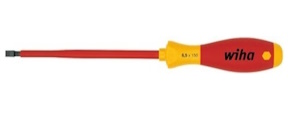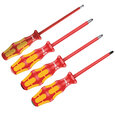What Is VDE Certification

Figure 1: VDE tested screwdriver
VDE certification signifies a product's adherence to European Union safety and quality standards in the electrical and electronic industries. It is awarded by the VDE Testing and Certification Institute in Germany and is a globally recognized certification mark of quality and reliability, boosting product credibility and market value. This article explores the meaning of VDE certification and the process of testing products for getting VDE approval.
Table of contents
- What is VDE certification?
- Products that need VDE certification
- VDE certification process
- Testing process
- VDE-GS certified mark
- VDE vs other standards
- FAQs
View our online selection of VDE tested screwdrivers!
What is VDE certification?
VDE, which stands for Verband der Elektrotechnik, Elektronik und Informationstechnik e.V. (Association for Electrical, Electronic, and Information Technologies), is a globally recognized and trusted certification body based in Germany. It specializes in testing and certifying electrical and electronic products to ensure they meet high safety, quality, and performance standards. VDE certification is widely acknowledged as a symbol of excellence and trust in the industry.
- Safety assurance: VDE certification ensures that products comply with stringent safety standards, minimizing the risk of electrical accidents and hazards.
- Quality assurance: Rigorous testing guarantees that VDE-certified products meet or exceed quality benchmarks, enhancing their performance and longevity.
- Regulatory compliance: Many countries require VDE certification for specific electrical and electronic products, making compliance essential for manufacturers and importers.
- Global acceptance: VDE certification enjoys global recognition, facilitating market access and building customer trust worldwide.
Products that need VDE certification
VDE certification is typically necessary for various industries' products containing electrical or electronic components. Some examples include:
- Consumer electronics: Household appliances like televisions, refrigerators, and washing machines
- Industrial equipment: Motors, control panels, and automation systems for manufacturing
- IT and telecommunication devices: Computers, routers, and telecommunication equipment
- Lighting: LED luminaires and other lighting products
- Renewable energy equipment: Solar panels, inverters, and wind turbines
- Medical devices: Healthcare equipment like patient monitors and diagnostic devices
- Electric vehicles (EVs) and charging stations: EVs and related infrastructure, including charging stations
VDE certification process
Obtaining VDE certification is meticulous and comprises several stages:
- Application: Manufacturers submit their products and detailed technical documentation to VDE for evaluation.
- Documentation review: VDE experts assess the submitted documents to ensure compliance with relevant safety standards.
- Sample testing: A product sample undergoes comprehensive testing, including electrical, mechanical, and environmental assessments.
- Factory inspection: On-site inspections may be conducted to verify consistent adherence to the approved design.
- Certification: If the product passes all tests and inspections, the VDE certification mark is granted, indicating conformity with safety and quality standards.
- Regular surveillance: Periodic audits and tests are conducted to ensure ongoing compliance.
Testing process
Insulated tools undergo a series of tests to secure the VDE rating. Each test guarantees that the tool is safe for anyone to handle, even when exposed to up to 1000 VAC voltages. Insulated tools bearing the VDE certification undergo rigorous testing, including:
- VDE voltage piece test: The tools are submerged in water for 24 hours, and 10 kV AC is applied for approximately three minutes. The tool passes the test if it produces no spark. The tools are certified for up to 1,000 V AC and 1,500 V DC upon passing.
- VDE cold shock test: Tools are cooled to -25°C (-13°F). The insulating material should remain intact when subjected to impacts and jolts.
- VDE adhesion test: The insulating material coating's adhesion is tested by applying a force of 500 N and storing it for 168 hours at 70°C (158°F). The insulating material must remain intact.
- VDE pressure test: The tool must not have any disruptive discharge at a pressure load of 20 N and a test voltage of 5 kV AC at 70°C (158°F).
- VDE combustion test: The insulating material must extinguish (within ten seconds) when exposed to a flame.
VDE-GS certified mark
The VDE certification involves a voluntary testing process where the manufacturer chooses to have their product tested to demonstrate that it complies with relevant standards. This certification primarily focuses on electrical safety.
The VDE-GS mark, on the other hand, signifies that a product meets German and European safety standards and has undergone additional, more rigorous testing and inspection processes. It is a higher level of certification and is recognized throughout the European Union. It also includes regular surveillance of the product. The double triangle (Figure 2) on the VDE-GS mark indicates the tool's suitability for working on energized parts.

Figure 2: VDE-GS stamp on a product
VDE vs other standards
VDE, UL, CSA, and cULus are marks that indicate a product has passed certain safety standards. Different organizations issue them, and are more widely recognized in different regions.
- VDE: VDE is widely recognized and accepted in Europe, especially Germany.
- UL (Underwriters Laboratories): UL is an American safety certification. Products with the UL mark have been tested and verified to meet UL's safety standards. The UL standard is recognized by many countries worldwide and is often required for products sold in the United States.
- CSA (Canadian Standards Association): This is a Canadian certification mark. Products with the CSA mark have been tested and verified to meet Canadian safety and performance standards. The CSA mark is widely recognized and accepted in Canada.
- cULus:cULus (Canadian Underwriters Laboratories) is a subsidiary of UL that develops and publishes standards for electrical and electronic equipment specifically for the Canadian market. OSHA recognizes the CULUS standard and is often required for products sold in Canada and the US.
The certification choice typically depends on the geographical area where the product will be sold. For example, a product intended for the European market might seek a VDE certification, while a product for the North American market might seek UL, CSA, or cULus certification. In some cases, products might have multiple certifications if sold in more than one region.
FAQs
What does VDE stand for?
VDE stands for 'Verband der Elektrotechnik,' which is German for the Association for Electrical, Electronic & Information Technologies.
What is VDE approval?
VDE certification is a globally recognized testing and certification mark for electrical and electronic products, ensuring their safety and compliance with international standards.
How can I check if a product has VDE certification?
Look for the VDE mark on the product or its packaging. Additionally, you can use the VDE Institute's online certification database to cross-verify.





